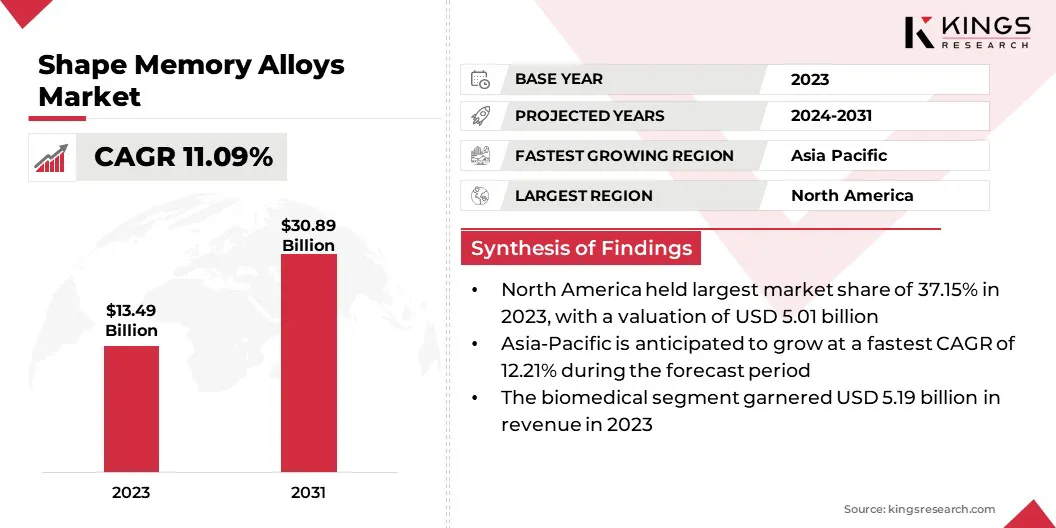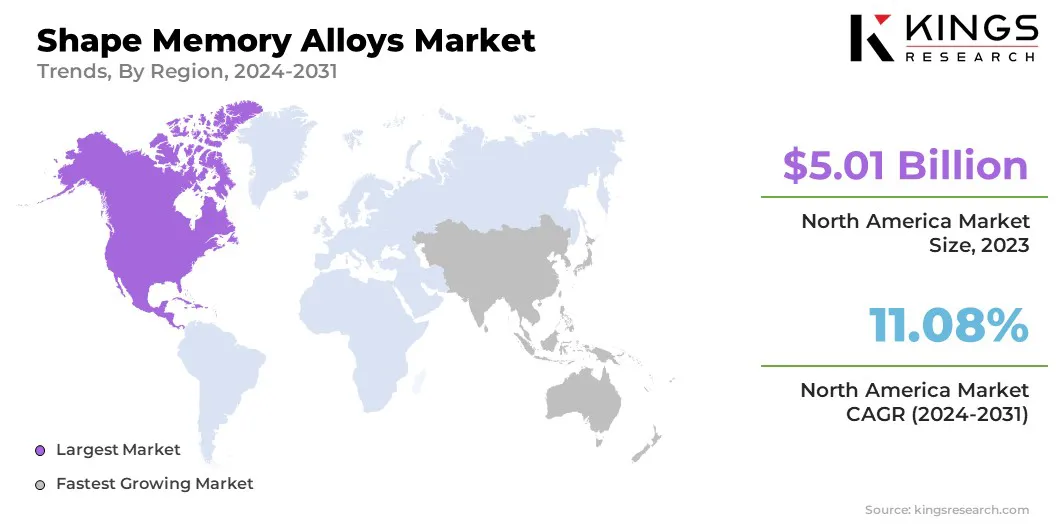Advanced Materials and Chemicals

Shape Memory Alloys Market

Shape Memory Alloys Market Size, Share, Growth & Industry Analysis, By Type (Nickel-Titanium (Nitinol) Alloys, Copper-Based Alloys, Others), By End-Use (Biomedical, Aerospace and Defense, Automotive, Electronics & Robotics, Others), and Regional Analysis, 2024-2031
Pages : 120
Base Year : 2023
Release : December 2024
Report ID: KR1161
Shape Memory Alloys Market Size
The global Shape Memory Alloys Market size was valued at USD 13.49 billion in 2023 and is projected to grow from USD 14.80 billion in 2024 to USD 30.89 billion by 2031, exhibiting a CAGR of 11.09% during the forecast period.
The market is experiencing steady growth due to the expansion of aerospace and defense sectors, as well as increased demand from the construction and building industry.
In the scope of work, the report includes services offered by companies such as DYNALLOY, Inc., Furukawa Electric Co., Ltd., SAES Getters S.p.A., Xi'an Saite Metal Materials Development Co., Ltd., TiNi Mechanisms, Metalwerks, Ultimate R&D, Johnson Matthey, Advanced Technology International, Confluent Medical Technologies, and others.
The evolution of tires is driving the growth of the shape memory alloys market.as companies are focusing on research and development for adopting in wide industries, shape memory alloys use for rover tires is increasing investment and innovation in aerospace sector. atest tire designs incorporate advanced materials to enhance their durability, adaptability, and performance.
For instance, NASA's Glenn Research Center (GRC), has developed a non-pneumatic, next generation, passive tire structure for mars mission, using shape memory alloys.
Building on previous advancements in airless tires for planetary rovers, this design incorporates high-strain capacity alloys as load-bearing components, enabling the structure to resist significant deformation without permanent damage. The design operate similarly to regular pneumatic tires, reducing the risk of punctures and pressure loss.
- For instance, in September 2023, The SMART tires company has launched latest METL airless tires. They are made from less rubber and can be reused.
Shape memory alloys (SMAs) are metal alloys that return to their original shape after deformation when exposed to heat. These alloys offer high elasticity, strength, and are lightweight. Common materials used in their production include nickel-titanium, iron-based, copper-based, cobalt-based, gold-based, and silver-based.
Shape memory alloys are extensively used in several sectors due to their super elasticity, particularly in aerospace and defense sectors. Their lightweight nature and resistance to harsh conditions make them ideal for applications such as vibration dampers, actuation systems, and morphing wings, enhancing aircraft performance and fuel efficiency.

Analyst’s Review
Major industry players are investing heavily in research and development to extend their product lines, which is fueling the growth of the market. Strategic activities such as product launches, partnerships, acquisitions, and increased investments enhance market presence.
To sustain competitiveness, industry participants must focus on providing low-cost products. High manufacturing costs and limited material options for specialized applications hinder market expansion.
However, ongoing research and development in production technologies, such as additive manufacturing and innovative alloy compositions, are expected to spur innovation while cutting costs. With rising demand for efficient and flexible materials, the market set to witness substantial growth, particularly in emerging markets.
Shape Memory Alloys Market Growth Factors
The increasing demand for consumer electronics is propelling the growth of the shape memory alloys market. Shape memory alloys enhance consumer electronics by enabling advancements in temperature sensors, eyeglass frames, actuators, vibration control, smartphone antennas, wearables, and sound systems, thereby improving functionality and user experience.
- In May 2023, the Japan Electronics and Information Technology Industries Association reported that Japan's total electronic equipment production reached USD 6,722 million.
This growth is further supported by the increasing adoption of smart gadgets, and wearable devices, which depend on adaptable and lightweight materials, thereby fueling the demand for shape memory alloys.
The shape memory alloys market faces several challenges due to the lack of standardized testing procedures. The complex behavior of these alloys under varying conditions, such as temperature, stress, and fatigue, poses difficulties in ensuring consistenant quality and performance.
This lack of uniform testing results in variability, raising reliability concerns, particularly in sectors such as aerospace and medical, where safety and reliability are essential. Inconsistent testing procedures hinder product evaluation and compliance with required standards, limiting widespread adoption. Without established procedures, the risk of failure in critical applications increases, compromising safety and efficiency.
Shape Memory Alloys Industry Trends
The increased investment in the biomedical industry has led to the growing demand for shape memory alloys, particularly in the manufacturing of innovative medical equipment and implants. Shape memory alloys, which are distinguished by their ability to return to a defined shape when heated, are increasingly employed in orthopedic devices, stents, and minimally invasive surgery equipment.
- For instance, in August 2024, the U.S. Food and Drug Administration (FDA) approved a new class of medical devices integrating advanced shape memory alloys, including surgical tools and stents, designed to enhance patient safety.
Shape memory alloys offer significant benefits, including improved patient outcomes, faster recovery times, and enhanced performance in complex medical procedures. Shape memory alloys are experiencing increased investment as healthcare infrastructure increases globally, particularly in developing nations, with a focus on innovative approaches that enhance surgical precision.
Advancements in material science and processing techniques are expanding the applications of shape memory alloys. New compositions, such as innovative nickel-titanium (NiTi) variations and iron-based alloys, improve the ability to recover from deformation at higher temperatures, along with improved mechanical qualities.
Additionally, processing methods such as additive manufacturing and advanced heat treatments allow for more precise control of the alloy's microstructure, boosting performance, durability, and functionality.
These advancements are expanding the use of shape memory alloys, particularly in the biomedical, aerospace, and automotive industries, where they are used as stents, actuators, and self-healing materials. Further study is anticipated to enhance the efficiency and adaptability, contributing to market expansion.
Segmentation Analysis
The global market has been segmented based on type, end-use, and geography.
By Type
Based on type, the market has been categorized into nickel-titanium (Nitinol) alloys, copper-based alloys, and others. The nickel-titanium (Nitinol) alloys segment led the shape memory alloys market in 2023, reaching a valuation of USD 6.59 billion.
Nickel-titanium (Nitinol) alloys are extensively utilized in the medical sector for their biocompatibility and superior mechanical properties. It is commonely empolyed in stents, orthodontic wires, and surgical equipment due to its flexibility and compatibility with the human body.
In the aerospace and automotive industries, Nitinol improves component performance by making them lighter, more durable, and corrosion resistant. Additionally, it offers high fatigue resistance, increased energy efficiency, and requires less maintenance, making it a more attractive material.
By End-Use
Based on end-use, the market has been bifurcated into biomedical, aerospace & defense, automotive, electronics & robotics, and others. The biomedical segment captured the largest revenue share of 38.43% in 2023.
The rising demand for shape memory alloys in neurosurgery, orthopedics, orthodontics, and endodontics is fostering the expansion of the segment. These alloys are widely used in medical devices.
Their unique ability to undergo deformation and return to their original shape makes them ideal for minimally invasive medical procedures, further boosting their demand in the biomedical industry.
Shape Memory Alloys Market Regional Analysis
Based on region, the global market has been classified into North America, Europe, Asia-Pacific, MEA, and Latin America.

North America shape memory alloys market accounted for the largest revenue share of 37.15% in 2023, with a valuation of USD 5.01 billion. This growth is largely attributed to the region's strong aerospace and defense industries, an advancde healthcare sector, and significant investment in research and development.
The high adoption rate of innovative medical technologies, particularly in the United States and Canada, boosts demand for shape memory alloys. Additionally, the presence of key players, established manufacturing infrastructures, and research institutions are further support the growth of the North America memory alloys market.
Asia-Pacific market is anticipated to witness significant growth, registering a robust CAGR of 12.21%. Countries such as China, Japan, India and South Korea are at the forefront of this growth due to their robust manufacturing capabilities and extensive research into smart materials.
Shape memory alloys are increasingly used in consumer electronics for compact, lightweight, and durable components, and in automotive applications such as actuators, sensors, and safety systems. Asia-Pacific is a hub for the automotive industry, utilizes shape memory alloys in various applications such as transmission systems and seat adjustments.
The region's automotive sector emphasizes advanced, lightweight materials to enhance safety and fuel efficiency. Additionally, the growing population and rising disposable income in countries such as China and India are fueling demand for innovative products across
Competitive Landscape
The global shape memory alloys market report will provide valuable insight with an emphasis on the fragmented nature of the industry. Prominent players are focusing on several key business strategies such as partnerships, mergers and acquisitions, product innovations, and joint ventures to expand their product portfolio and increase their market shares across different regions.
Companies are implementing impactful strategic initiatives, such as expanding services, investing in research and development (R&D), establishing new service delivery centers, and optimizing their service delivery processes, which are likely to create new opportunities for market growth.
List of Key Companies in Shape Memory Alloys Market
- DYNALLOY, Inc.
- Furukawa Electric Co., Ltd
- SAES Getters S.p.A.
- Xi'an Saite Metal Materials Development Co., Ltd.
- TiNi Mechanisms
- Metalwerks
- Ultimate R&D
- Johnson Matthey
- Advanced Technology International
- Confluent Medical Technologies
Key Industry Developments
- September 2024 (Launch): SAES Getters S.p.A. introduced a new range of shape memory alloys (SMAs) designed for medical applications. These alloys offer enhanced biocompatibility and mechanical properties to meet the rising demand for innovative solutions in minimally invasive procedures.
- July 2024 (Launch): Johnson Matthey launched a new shape memory alloy material with enhanced shape recovery and durability.
The global shape memory alloys market has been segmented as:
By Type
- Nickel-Titanium (Nitinol) Alloys
- Copper-Based Alloys
- Others
By End-Use
- Biomedical
- Aerospace & Defense
- Automotive
- Electronics & Robotics
- Others
By Region
- North America
- U.S.
- Canada
- Mexico
- Europe
- France
- UK
- Spain
- Germany
- Italy
- Russia
- Rest of Europe
- Asia-Pacific
- China
- Japan
- India
- South Korea
- Rest of Asia-Pacific
- Middle East & Africa
- GCC
- North Africa
- South Africa
- Rest of Middle East & Africa
- Latin America
- Brazil
- Argentina
- Rest of Latin America
CHOOSE LICENCE TYPE
Frequently Asked Questions (FAQ's)
Get the latest!
Get actionable strategies to empower your business and market domination
- Deliver Revenue Impact
- Demand Supply Patterns
- Market Estimation
- Real-Time Insights
- Market Intelligence
- Lucrative Growth Opportunities
- Micro & Macro Economic Factors
- Futuristic Market Solutions
- Revenue-Driven Results
- Innovative Thought Leadership
